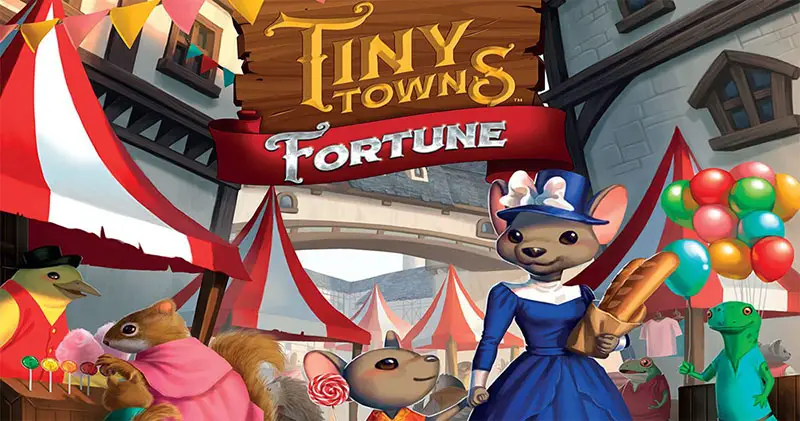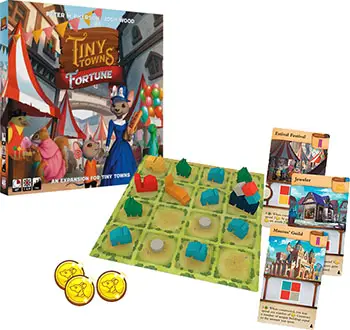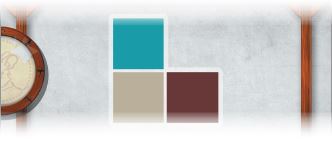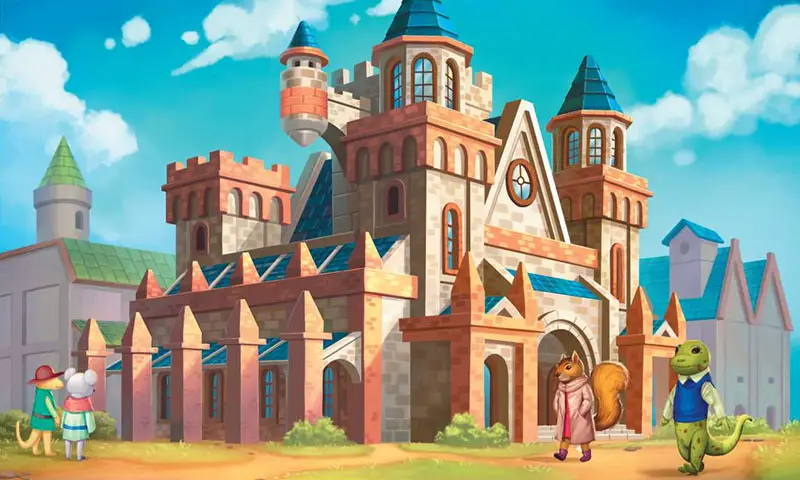
In Tiny Towns: Fortune, the creatures of the forest have found a way to trick each other into thinking shiny bits of metal have arbitrary value . It's very useful-so much so that you can use this thing called "money" to get other creatures to give you almost anything in return for the right number of shiny bits. If only earning money weren't so difficult!
These shiny bits are called Quercs, but for some reason everyone always ends up calling them "coins". When the creatures of the forest ran out of space and began digging into the hills to make room, they came across a fairly useless metal.
It's no good for building, so they melted it down and molded it into the small circles now known as Quercs. Even a single Querc is valuable enough to increase the worth of a town or be traded for different building resources.
Surely this new " money" thing will bring nothing but good fortune and kindness to the creatures of Tiny Towns!
Components

- 6 Chest boards
- 30 coins
- 10 wooden Resource cubes
- 12 Building cards
- 10 Monument cards
- 1 scorepad
- Rulebook
Setup
-
Place the coins on the table in a general supply where all players can reach them.
-
Give each player a Chest board, which will be placed next to each player's town.
-
Separate the new Fortune Building and Monument cards by the symbols on the back and shuffle them into the setup piles of cards from the base game.
For the best experience, play with a maximum of 4 Fortune buildings- although you can play with more. You can also play Tiny Towns: Fortune without using any of the Fortune buildings or monuments, simply using the rules for gaining, storing, and using coins.
-
Follow the normal Tiny Towns setup rules.
Game Play
Round Overview
-
The Master Builder names a type of resource.
-
All players MUST take a cube of this resource and place it in an empty square in their town grid OR spend 1
 to the general supply to place a different resource.
to the general supply to place a different resource. -
Players may construct any buildings for which they have the matching resources in the correct shape.
Important: A player who is constructing multiple buildings must construct those buildings one at a time, resolving each building's costs/effects separately.
The player chooses the order in which those buildings are constructed.
-

After all buildings are constructed and their costs and effects are resolved, players gain exactly 1 coin if they constructed 2 or more buildings this round.
-
A new round begins. The Master Builder token passes to the player on the left.
In Tiny Towns: Fortune, players can gain and use coins ( ) in various ways.
) in various ways.
A. Gaining
The primary way players gain  is by constructing 2 or more buildings in a single round. Certain Building and Monument cards also allow players to gain coins.
is by constructing 2 or more buildings in a single round. Certain Building and Monument cards also allow players to gain coins.
At the end of a round in which a player constructs 2 or more buildings by removing resources (as opposed to constructing via monument abilities), that player gains exactly 1 coin.
Consequently, players will be more likely to choose not to construct a building immediately upon placing resources in the correct shape, waiting until a future round in which they can construct multiple buildings.
Constructing more than 2 buildings in a single round does not gain players additional coins.
Note:  , like resource cubes and buildings, are unlimited. If you run out, substitute some other marker.
, like resource cubes and buildings, are unlimited. If you run out, substitute some other marker.
B. Storing
Players may store up to a maximum of 4  at once. Players should place any coins they gain into 1 of the 4 spaces on their Chest board.
at once. Players should place any coins they gain into 1 of the 4 spaces on their Chest board.
If players already have 4 coins in their Chest and gain another Q, too bad-they do not gain that  unless a constructed Monument card gives them an extra space to hold 1 coin.
unless a constructed Monument card gives them an extra space to hold 1 coin.
Some Monument cards have an extra space to hold 1  , which becomes available once the monument is constructed.
, which becomes available once the monument is constructed.
 Coin Slot |
C. Using
Each  is worth 1
is worth 1  at the game end.
at the game end.
Players can also spend 1 coin to the general supply to place a different resource in their town than the resource named by another player as Master Builder.
This does not affect what any other player places and any number of players may do this per round (except the Master Builder).
Special Note
Whenever a building is placed by any means (such as with the monuments Architect's Guild, Grove University, and Opaleye's Watch from the base game), players still must spend coin for that building's construction cost, if there is any. Players also receive the benefits of constructing that building, such as  for Mine and Statue, or a Shed being able to be placed on any empty square.
for Mine and Statue, or a Shed being able to be placed on any empty square.
Feeding your Buildings
Remember! Just as in the base game, feeding  buildings is resolved at the end of the game. This means that any coin required for feeding
buildings is resolved at the end of the game. This means that any coin required for feeding  buildings must be spent at game end. Players cannot hold on to
buildings must be spent at game end. Players cannot hold on to  if they still have unfed
if they still have unfed  buildings they can spend coin to feed.
buildings they can spend coin to feed.
Town Hall
When playing Town Hall with Tiny Towns: Fortune, do not use Oddity Shop  . Players may spend 1
. Players may spend 1  to place a different resource than the one drawn from the Resource deck.
to place a different resource than the one drawn from the Resource deck.

Building Clarifications

Root Root Cellar
At game end, you choose which rows or columns you would like to spend coin to feed. However, you cannot hold on to  if you still have any unfed
if you still have any unfed  buildings you can spend to feed. You must spend your coin to feed
buildings you can spend to feed. You must spend your coin to feed  buildings if you can.
buildings if you can.

Schoolhouse
If you and the player on your right both have 0 coin at game end, you do score the additional 2  . A Schoolhouse not adjacent to a fed
. A Schoolhouse not adjacent to a fed  is worth 0
is worth 0  and cannot score the additional 2
and cannot score the additional 2  for
for  at game end.
at game end.

Little Barn
A single  building still costs 1 coin to feed. If you have 3
building still costs 1 coin to feed. If you have 3  buildings, it costs 2 coins to feed them all. If you do not have enough coin to feed all your
buildings, it costs 2 coins to feed them all. If you do not have enough coin to feed all your  buildings, you can choose which ones remain unfed.
buildings, you can choose which ones remain unfed.
However, you cannot hold on to  if you still have any unfed
if you still have any unfed  buildings you can spend to feed. You must spend your coins to feed
buildings you can spend to feed. You must spend your coins to feed  buildings if you can.
buildings if you can.

Jeweler
You must spend 1 coin if you have it. If you don't, all other players gain 1 coin at the end of the round, including players whose towns are already complete.

Statue
The Statue being constructed counts toward the number of  you have. Therefore, if it is the third Statue you built, you gain 1 coin.
you have. Therefore, if it is the third Statue you built, you gain 1 coin.

Teahouse
Teahouse does not count itself as a unique building type. If there is another Teahouse in the same row or column, then that does count as a unique building type.
The most  you can gain from constructing a Teahouse is 3 coin. If you are counting the unique building types in the same row as Teahouse, then the buildings in the column are not counted, and vice versa.
you can gain from constructing a Teahouse is 3 coin. If you are counting the unique building types in the same row as Teahouse, then the buildings in the column are not counted, and vice versa.

Cathedral
A Cathedral adjacent to another Cathedral is worth 0  . If, because you don't have 3 coins or choose not to spend it, you remove the Cathedral and construct a
. If, because you don't have 3 coins or choose not to spend it, you remove the Cathedral and construct a  , you get the benefit of the
, you get the benefit of the  .
.
If you construct a Shed this way, you may move it to any open space on your board.

Museum
No matter how many Museums you have constructed, you may only return 1 resource to the general supply for 1 coin per round.
The resources on each Museums may be the same or different.

Parsonage
A Parsonage not adjacent to a fed  is worth 0
is worth 0  . You only need to have 1 coin for each
. You only need to have 1 coin for each  in your town - you don't spend the coin).
in your town - you don't spend the coin).
If you have no coin, you may construct a Parsonage regardless of how many  you have. If you have more coin than the number of
you have. If you have more coin than the number of  you still lose all of your coin.
you still lose all of your coin.

Oddity Shop
When another player names a resource, you may place the resource on Oddity Shop instead of placing it on your board.
At the start of a player's turn as Master Builder, that player may take 1 resource from 1 other player's Oddity Shop, place it on their board, and gain 1 @c.jpgfrom the general supply before naming a resource as Master Builder.
You cannot construct buildings immediately after placing a resource from another player's Oddity Shop. If a resource from Oddity Shop fills your board, your town is complete. Resources taken from Oddity Shop cannot be changed by spending coin.

Gamblers' Den
You do not spend the 1 coin.
Monument Clarifications

Caterina's Grotto
 can share a square with a resource cube. If there is already a building on one of the center squares (including Caterina's Grotto itself), you immediately gain the coin that would be placed there. If any coin are left in your town at game end, remove them- they do not count for
can share a square with a resource cube. If there is already a building on one of the center squares (including Caterina's Grotto itself), you immediately gain the coin that would be placed there. If any coin are left in your town at game end, remove them- they do not count for  .
.

The Petal Promenade
You may pay 1 coin to the general supply to place a different resource than the one named by another player, as normal. That new resource still must be placed on a square with a and you gain that coin.
and you gain that coin.
You may not place resources you name as Master Builder on squares containing  .
.
If you are the last player whose town is not complete or if it is your turn as Master Builder and you can't place the resource you named on an empty square without a coin, you may place it on a square with a coin, gaining that coin).

Eraflage Vineyard
If there are buildings of the same type in both the same row and column as Eraflage Vineyard, that building type only counts once for -2  . Eraflage Vineyard does not count itself when counting building types in the same row and column.
. Eraflage Vineyard does not count itself when counting building types in the same row and column.

Estival Festival
If you cannot spend 2 coins, you cannot construct Estival Festival. Leftover  at game end are worth 2
at game end are worth 2  instead of 1
instead of 1  .
.

The Prism Forge
For resource cubes that are part of overlapping layouts of buildings that are ready for construction, The Prism Forge allows you to use those cubes twice in the same round to construct 2 unique building types.
Resolve the costs and effects of each building separately, as normal.

Hollow Hill
The coin placed on the Hollow Hill card is only for keeping track of negative  . You may not spend this coin.
. You may not spend this coin.

Masons' Guild
You must spend the entire amount of coin first. Then construct the buildings one at a time, resolving separately each building's costs and/or benefits.

Southern Semaphore
The additional resource from Southern Semaphore must be placed on an empty square in your town and cannot be placed on or swapped with resources on  buildings. This additional resource cannot be changed into another type of resource by any method.
buildings. This additional resource cannot be changed into another type of resource by any method.
With Factory  , it is possible to place a different type of resource for the initial resource, but the additional resource must be of the type the Master Builder named.
, it is possible to place a different type of resource for the initial resource, but the additional resource must be of the type the Master Builder named.
End of the Game
The game ends and is scored per normal Tiny Towns rules, with the addition of 1  for each leftover
for each leftover  a player has.
a player has.
Solo Variant
When playing the Solo variant with Tiny Towns: Fortune, do not use Oddity Shop  , Schoolhouse
, Schoolhouse  , or Southern Semaphore
, or Southern Semaphore  . With Jeweler
. With Jeweler  , you must be able to spend 1 coin or you may not construct this building.
, you must be able to spend 1 coin or you may not construct this building.
You may spend 1 coin to place a different resource than shown on the Resource card you select. Place the card face-down on the bottom of the draw pile as normal.
Continue Reading

